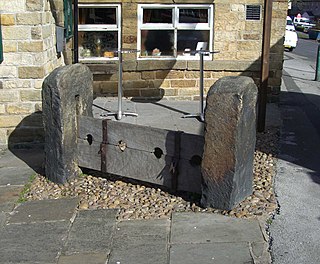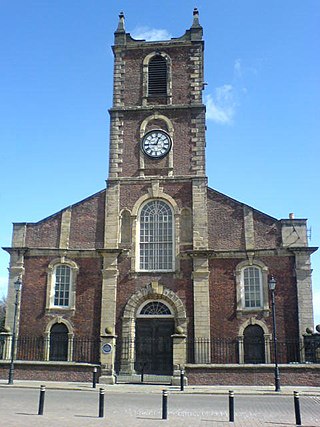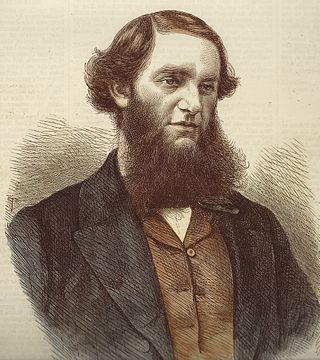
Hallamshire is the historical name for an area of South Yorkshire, England, approximating to the current City of Sheffield local government area.

High Bradfield is a rural village 6.5 miles (10 km) north-west of the centre of Sheffield in South Yorkshire, England and within the city's boundaries. The village lies just within the Peak District National Park, 1.3 miles (2 km) inside the park's north-eastern border, is at an altitude of 260 metres (850 feet) AOD, and has extensive views across Bradfield Dale towards Derwent Edge and the Dark Peak.

Handsworth is a suburb of south eastern Sheffield, in South Yorkshire, England. It covers an area of approximately 5 square miles (13 km2), and has a population of approximately 9,957. It has five schools, four churches, a variety of small shops, a large supermarket, and a range of commercial and light industrial businesses. Until 1974 it was in the West Riding of Yorkshire.
Ecclesfield is a village and civil parish in the City of Sheffield, South Yorkshire, England, about 4 miles (6 km) north of Sheffield City Centre. Ecclesfield civil parish had a population of 32,073 at the 2011 Census. Ecclesfield wards of the City of Sheffield had a population of 35,994 in 2011. The population of Ecclesfield village stood at 7,163 in the most recent census.
Wadsley Bridge is a suburb of Sheffield, South Yorkshire, England, 3 miles (4.8 km) northwest of the city centre. The area is a mixture of residential housing and small industrial and commercial premises. The suburb falls within the Hillsborough ward of the City.

Wadsley is a suburb of the City of Sheffield in South Yorkshire, England. It stands 3 miles (5 km) north-west of the city centre at an approximate grid reference of SK321905. At the 2011 Census the suburb fell within the Hillsborough ward of the City. Wadsley was formerly a rural village which was engulfed by the expansion of Sheffield in the early part of the 20th century.

Under the feudal system in England, a feoffee is a trustee who holds a fief, that is to say an estate in land, for the use of a beneficial owner. The term is more fully stated as a feoffee to uses of the beneficial owner. The use of such trustees developed towards the end of the era of feudalism in the Middle Ages and declined with the formal ending of that social and economic system in 1660. The development of feoffees to uses may have hastened the end of the feudal system, since their operation circumvented vital feudal fiscal mechanisms.
The charitable trust known as The Lords Feoffees and Assistants of the Manor of Bridlington, based in Bridlington, East Riding of Yorkshire, England, was created in 1636.

Cestui que is a shortened version of "cestui a que use le feoffment fuit fait", lit. 'the person for whose use/benefit the feoffment was made'; in modern terms, it corresponds to a beneficiary. It is a Law French phrase of medieval English invention, which appears in the legal phrases cestui que trust, cestui que use, or cestui que vie. In contemporary English the phrase is also commonly pronounced "setty-kay" or "sesty-kay". According to Roebuck, Cestui que use is pronounced. Cestui que use and cestui que trust are often interchangeable. In some medieval documents it is seen as cestui a que. In formal legal discourse it is often used to refer to the relative novelty of a trust itself, before that English term became acceptable.

High Green is a
suburb of Sheffield, England, located about 8 miles from the city centre. It is found to the north of Chapeltown and is served by buses; the nearest rail station is in Chapeltown 1 mile away. The suburb falls within the West Ecclesfield ward of the city Council.

The Churches Conservation Trust is a registered charity whose purpose is to protect historic churches at risk in England. The charity cares for over 350 churches of architectural, cultural and historic significance, which have been transferred into its care by the Church of England.

Ecclesfield East railway station was built by the South Yorkshire Railway on their "Blackburn Valley" line between Sheffield Wicker and Barnsley. The station was intended to serve the parish of Ecclesfield, near Sheffield, South Yorkshire, England, although it is some distance from the centre of the village.
Sheffield City Trust is a registered charity in the United Kingdom that owns and/or manages fifteen entertainment and sports venues in Sheffield, South Yorkshire, England.

Parkin Jeffcock was an English mining engineer who died trying to effect the rescue of miners during the Oaks mining disaster which eventually killed more than 350 people.
The Sheffield Town Trust, formerly officially known as the Burgery of Sheffield, is a charitable trust operating in Sheffield, South Yorkshire, England.

The Church of St Mary, Ecclesfield, is situated on Church Street in the village of Ecclesfield, Sheffield, South Yorkshire, England. It is situated 4.3 miles (7 km) north of the city centre. It is a Grade I listed building, one of only five within the Sheffield city boundary. It was originally the parish church for Hallamshire, one of the largest parishes in England and in the seventeenth century was known as the "Minster of the Moors" due to its then rural situation.
The Church Burgesses, formerly known officially as the Twelve Capital Burgesses and Commonalty of the Town and Parish of Sheffield, are a charitable organisation in the city of Sheffield in South Yorkshire.

St Paul's Church is situated within the city of Sheffield, South Yorkshire, England, in the suburb of Parson Cross on Wordsworth Avenue. St Paul's is a modern looking post war church which has been designated as a Grade II* listed building.

Christ Church is an Anglican place of worship situated on Church Street in the Stannington area of the City of Sheffield, England. It is a Commissioners' church or “Million Church” as it was built partly with money provided by the Church Building Act of 1824. It is recorded in the National Heritage List for England as a designated Grade II listed building.

Wigtwizzle is a hamlet in the civil parish of Bradfield, in South Yorkshire, England. The hamlet is 6 miles (9.7 km) south of Penistone, and 12 miles (19 km) north west of Sheffield.













